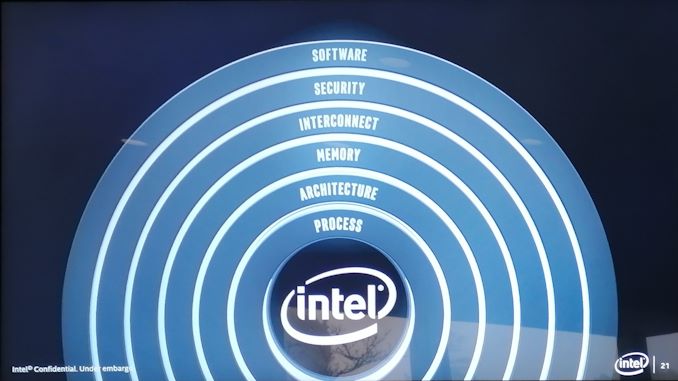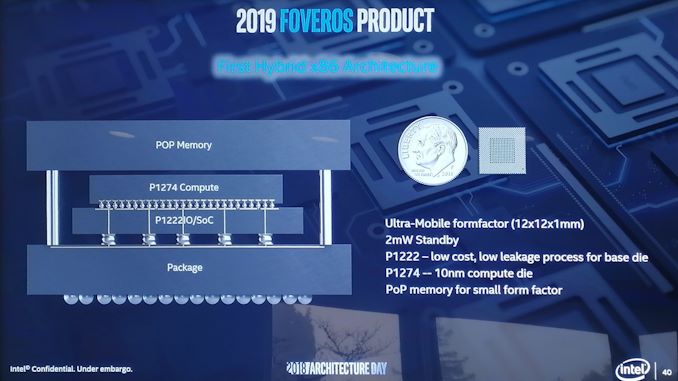Intel's Architecture Day 2018: The Future of Core, Intel GPUs, 10nm, and Hybrid x86
by Dr. Ian Cutress on December 12, 2018 9:00 AM EST- Posted in
- CPUs
- Memory
- Intel
- GPUs
- DRAM
- Architecture
- Microarchitecture
- Xe
Intel Made Something Really Funny
Q&A with Raja, Jim, and Murthy
Through Intel’s Architecture Day, the company did a couple of side discussions for a few journalists to speak to Raja Koduri and Jim Keller in a round-table format. Beyond that, Murthy Renduchintala and Raja also held a Q&A session at the end of the day. They answered questions on 10nm, the new Foveros technology, Thunderbolt 3 adoption, and how Intel will approach 5G.
For this article, the Questions and Answers will be listed as an abridged version of the responses, due to time constraints and live transcription, with questions grouped based on topic. Different members of the press asked these questions.
Q: A lot of the CPU microarchitecture at Intel has been hamstrung by delays on process node technology. What went wrong, and what steps have been made to make sure it doesn't happen again?
R/J: Our products will be decoupled from our transistor capability. We have incredible IP at Intel, but it was all sitting in the 10nm process node. If we had had it on 14nm then we would have better performance on 14nm. We have a new method inside the company to decouple IP from the process technology. You must remember that customers buy the product, not a transistor family. It’s the same transformation AMD had to go through to change the design methodology when they were struggling. At Apple it was called the ‘bus’ method.
M: This is a function of how we as a company used to think about process node technologies. It was a frame tick (limiting factor) for how the company moved forward. We've learned a lot about how this worked with 14nm. We now have to make sure that our IP is not node-locked. The ability to have portability of IP across multiple nodes is great for contingency planning. We will continue to take aggressive risks in our designs, but we also will have contingency. We need to have as much of a seamless roadmap as possible in case those contingencies are needed, and need to make sure they are executed on ASAP if needed to keep the customer expectations in line. You will see future node technologies, such as 10/7, have much more overlap than before to keep the designs fluid. Our product portfolio on 14nm could have been much better if our product designs were not node-locked to 10nm.
R: In the future there will be no transistor left behind, no customer left behind, and no IP left behind.
Q: Will we ever see a 10nm monolithic desktop CPU at the high end?
R: Yes.
Q: How is 10nm? Has it changed?
R: It is changing, but it hasn't changed. There are a lot of lessons learned in how Intel approached it to begin with. We are established a much better model between manufacturing and design. We want good abstractions in product and process node going forward. When everything was going well, this issue didn't manifest and so wasn't an issue. There's complexity here when something bad happens on process, so the whole pipeline clogs up - the rest of the world solves this with abstraction. We need to make sure it won't happen again, and we have a desire to build resilience in the roadmap.
Q: Are there plans for mixed SoCs, combining CPU / GPU / AI / FPGA ?
R: In our roadmap there will be scalable vector/matrix combinations. What our customers want are very scalable solutions. Customers want similar programming models regardless of the silicon.
Q: What has been the effect of hiring Raja/Jim and bringing outsiders to Intel?
M: Intel is very innovative. We want to add to that chemistry and make sure we bring in people who understand Intel but also bring in good ideas. It's about respecting the rest of the market and make sure Intel is competitive. It's balancing the centre of internal debates by making sure we are challenging internal beliefs and the status quo by bringing in people who have done this sort of thing before. It shows to Intel's strengths in its ability to absorb interesting ideas from the outside. We went for the very best on the outside because that was what required to join with the very best on inside.
Q: What is Intel’s current approach to 5G, given the topics discussed today?
M: We think about 5G from the datacentre to the network to the edge and to the device. We at Intel believe the transition to 5G and its implications on the network, in terms of accelerating data and catalysing a software defined network where bespoke silicon gets replaced by containers, is as transformative as the jump from analogue to digital. It will accelerate the ‘cloudification’ of the network. The edge is important, especially to minimize latency for new services. Sub-millisecond latency for these services is critical. The over-the-air interface is important too. The intelligent cloud domain is going to be the flywheel about how fast the industry evolves. We mentioned in November that our XMM 5G modem will be in the hands of partners in the second half of 2019 with products in early 2020. It is a multi-mode 5G LTE architecture from day one, supporting all 3 mmWave bands, and sub-6 GHz frequencies.
Q: As Thunderbolt 3 requires additional chips, how do you see future OEM adoption?
M: Integrated Type-C Thunderbolt 3 is the first generation. We will refine it in the future - that's the natural genealogy of the technology. We constantly think about how much we integrate into the chip and how much we leave on the board.
R: This is a big IP challenge, not only for TB3, but for other IP. Integrated PHYs are important. For example, by disaggregating the transceiver in our FPGA line-up, it has allowed us to focus on that decoupled IP a lot.
Q: In the demo of FOVEROS, the chip combined both big x86 cores built on the Core microarchitecture and the small x86 cores built on the Atom microarchitecture. Can we look forward to a future where the big and little cores have the same ISA?
R: We are working on that. Do they have to have the same ISA? Ronak and the team are looking at that. However I think our goal here is to keep the software as simple as possible for developers and customers. It's a challenge that our architects have taken up to ensure products like this enter the market smoothly. We’ll also have a packaging discussion next year on products like this. The chip you see today, while it was designed primarily for a particular customer to begin with, it’s not a custom product, and in that sense will be available to other OEMs.
M: We've made the first step on a journey. That first step is a leap, and the next step is incremental. As we've said about One API strategy – if we homogenise the API then it'll go into all our CPUs. FOVEROS is also a new part/product that shows that we had a gap in our portfolio – it has helped us create technologies to solve an issue and we expect to expand on this in the future with new IP.
Q: Are you having fun with FOVEROS?
J: Because Raja deals in GPUs, he’s having fun with high bandwidth communications between compute elements. It's a new technology and we're having some experimentation with it. What is frustrating is that as an industry we hit a limit for current flux density a year before stacking technology became viable, so for high performance on stacking we're trying a lot of things in different areas. There's no point having to make thermal setbacks if it also removes the reason why you're using the technology. But we're having fun and trying a lot, and we'll see FOVEROS in a number of parts over the next 5 years. We will find new solutions to problems we don't even know exist yet.
Q: When is Manufacturing Tech Day?
M: We will tell you when it happens! I'm sure you all have opinions on Intel 10nm right now and yes we are looking at what we're doing, eating an amount of humble pie, but we're re-adjusting our process to make sure that we can take the best process no matter what the product is.
The title of this page was a quote from Jim during the Q&A: 'At some point in the future you'll read an article with the title Intel Made Something Really Funny.'. I think I win this bet...

















148 Comments
View All Comments
peevee - Tuesday, December 18, 2018 - link
"Normally cache misses decrease by a factor of a square root of the proportional size when the cache is increased"This is neither true in most performance-critical real cases nor can provide any estimate of actual performance increase.
mikato - Friday, December 21, 2018 - link
I'm here for the "raja inside" comments. Disappointed.peevee - Sunday, December 23, 2018 - link
"although it was pointed out that these improvements won’t help everyone, and might require new algorithms in order to use specific parts of the core."Which means it will help almost no one, as very few will optimize specifically for that core.
"We’re waiting to see what changes Intel has made on the front-end, which is where a lot of low-hanging fruit often lies for performance."
Low-hanging fruit in x86 was picked up in Pentium. Since then it is just more and more kludges which cost more energy than improve performance (normalizing for node).
peevee - Sunday, December 23, 2018 - link
"64 EUs... Each EU will support seven threads as before, which means that the entire GT2 design will essentially have 512 concurrent pipelines."Math?
And are these threads? Or ALUs?
peevee - Sunday, December 23, 2018 - link
"The 7-Zip demo was relatively straight forward, showing how the new instructions such as Vector-AES and SHA-NI in Sunny Cove can give the processor a 75% boost in performance over an equivalent Skylake based platform at iso-frequency."Huh? Have they recompiled (what compiler supports the new instructions then), or manually wrote a codepath in asm? And enabled encryption so to get any increase, so the increase is not actually for compression? Have they disabled compression too? ;)
dampf - Wednesday, January 2, 2019 - link
Really Intel? Adding AI improvements to Core architecture in 2021? Smartphone vendors were doing it last year... way too late. And 5G will take off in the end of 2019.TheJian - Wednesday, January 2, 2019 - link
I guess I'm not getting why I should be impressed by this.https://www.electronicsweekly.com/news/design/comm...
Leti already did it? They say it's IP can be used by others, so is this Intel's solution (what they're using I mean)?
AMD already does chiplets, everyone does socs (Intel failed them)...etc. 144mm^2 not that small (about an large apple soc size). Current 7nm A12 is 83mm^2 with 6.9B transistors and two big cores, 4 small. AMD already did interposer/chiplets. Memory has been stacking for a while now. Not sure what is supposed to impress me here.
"Very much like a mobile chip" ...Pretty much...Again, why so impressed?
And as OP noted, you have no idea how big the market is, nor how much they can make on them. I think they have to try to sell some before we can say that (many Intel things killed over the years), as their last mobile strategy cost them 16B+ in giveaways, and lost the fab race for a while (maybe forever, because that 16B lost should have went DIRECTLY into fabs and 10nm wouldn't be crap now), as once 7nm Intel hits, it looks like TSMC beats them anyway with 5nm (ok, tie? whatever). My point here is Intel's 7nm won't be much ahead of tsmc 5nm if at all as that is what it will compete with since tapeouts happen q2 2019 and chips 12-15 months later.
https://www.extremetech.com/computing/278742-tsmc-...
Many other articles out there like this, but has a good chart of when and how much wafers etc. But if risk production is really as they say, 5nm chips by xmas 2020. That puts Intel where with this @7nm? Unless that answer is XMAS 2020, I'm thinking behind tsmc. It looks like TSMC is aiming before xmas and they've been moving at a good clip without many glitches recently, so Intel better get busy IMHO. TSMC is 2q 2019 risk, or 2H 2019 depending on who you believe I guess. But still, Intel 7nm better hit by xmas 2020 then right?
Comments on last page: Uh, should have bought NV under $10 but couldn't take the best from gpu side because nobody could handle Jen as president :) WOW, look at that value you passed up Intel, oh, and you'd RULE mobile by now with all those tegras being on Intel's process 5+yrs ago (never mind what gpus would have done on Intel during this time) and you already had the modem solution too (NV bought one, and had to kill it, intel would have taken over everything cpu/gpu/modem/mobile).
With chromebooks, 2b mobile units not using NV gpu's etc, nobody would have stopped them at FTC since more gpus, and arguably more computing devices ship without WINTEL, Intel's gpus (even with NV in there) etc. Intel gpus wouldn't have been needed, mobile wouldn't have been lost (14nm Intel NV socs would have competed well against 20nm everyone else, same story before 14/20, Intel 22nm NV socs vs. 28nm everyone else)., fab money wouldn't have been blown on mobile etc etc. All the problem Intel has now are because they blew 16B on failing instead of BUYING NV for that or a bit more. They had a value back then ~6B or less 659mil shares at $10, I bought at 12...ROFL. They should have owned NV anywhere in there and all this crap wouldn't have happened...LOL. We'll see how this "ideas from outside" crap works out now. To be fair AMD had the same problems to some extent, firing Dirk for not liking mobile/tablet/apu, and wanting a KING first then that cheap crap later. Now they chase king cpu (not gpu yet so far) again...LOL. Yeah, I own AMD stock but still think management is dumb. Can't price anything right, always trying to be a friend or get share which means NOTHING if it doesn't come with MARGIN as a poor man. Sure the rich guy can flood a market, kill enemy sales, but only because he has wads of cash and can wait until he breaks you. Poor company needs NET INCOME for the next gen R&D and to retain people like KELLER etc.
I'm only in AMD stock for the 7nm server stuff, then out likely. Rumor/hype work well in advance of real product at amd (talking stock price here), so you don't likely have to wait for anything other then "shipping soon" or some leaked benchmarks etc. and the price will head to 40+ probably. Just run before that reality hits or brave the waves...LOL. I think AMD will make money, certainly has the server chips to do it, but management just seems to fail at pricing anything to take advantage while they can. Too worried about market, instead of MARGIN for R&D. I'd rather own the 10% that makes most of the money than the 80% that makes crap+a little midrange crap. Apple thinks the same, see their Q reports for ages etc. Own the rich so you can afford to supply the poor. It doesn't work the other way around generally speaking, especially as the little guy. You can't bleed as the poor little guy ;)
TheJian - Wednesday, January 2, 2019 - link
One more point, in case anyone brings it up, A12x 122mm^2 10B transistors. just adds two more big cores IIRC (maybe a few other small changes). Same point though.